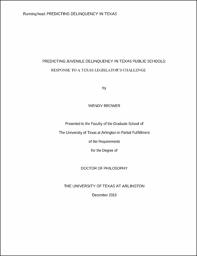
ATTENTION: The works hosted here are being migrated to a new repository that will consolidate resources, improve discoverability, and better show UTA's research impact on the global community. We will update authors as the migration progresses. Please see MavMatrix for more information.
Show simple item record
| dc.contributor.advisor | Trache, Maria | |
| dc.creator | Brower, Wendy | |
| dc.date.accessioned | 2020-01-09T20:31:35Z | |
| dc.date.available | 2020-01-09T20:31:35Z | |
| dc.date.created | 2019-12 | |
| dc.date.issued | 2019-12-03 | |
| dc.date.submitted | December 2019 | |
| dc.identifier.uri | http://hdl.handle.net/10106/28825 | |
| dc.description.abstract | The purpose of this study is to engage in a systematic inquiry of juvenile delinquency in Texas public schools and respond to the statement made by a member of the Texas Legislature who challenged public school officials to predict delinquency in order to keep students out of the court system. The study is based on the assumption that a profile for juvenile delinquency can be developed using the existing data submitted by Texas public school districts through the Public Education Information.
This is a quantitative study that first explored teh profile for deliqnuent and non-deliquent at-risk students. next, the study used a logistic regression model to establish the relationship between delinquency status and other demographic and at-risk indicators. Finally, stepwise logistic regression was used to identify what combination of indicators was most predictive of delinquency. Although the study shows that school-related indicators alone are not enoguh to develop a comprehensive profile for juvenile delinquency, the analysis revealed that the best set of variables describing a delinquency profile included gender, grade level, math achievement, LEP (Limited English Proficiency), truancy, and DAEP (Disciplinary Alternative Educational Program) placement. Students who are designated at risk essentially place educators on the clock in terms of providing effective interventions before tehy enter the pipeline into the criminal justice system.
The study provided insights into next steps and direction for future research to develop proactive measures toward interagency collaboration and targeted intervention strategies to further address this charge. Districts must extend the scope of data collection available and the time duration for which data is reported, and legislators must expand the scope of state statute which identifies students as "at-risk" to include being at risk for delinquency. | |
| dc.format.mimetype | application/pdf | |
| dc.language.iso | en_US | |
| dc.subject | Delinquency | |
| dc.subject | Public schools | |
| dc.subject | At-risk students | |
| dc.title | Predicting Juvenile Delinquency in Texas Public Schools: Response to a Texas Legislator's Challenge | |
| dc.type | Thesis | |
| dc.degree.department | Educational Leadership and Policy Studies | |
| dc.degree.name | Doctor of Philosophy in Educational Leadership and Policy Studies | |
| dc.date.updated | 2020-01-09T20:31:36Z | |
| thesis.degree.department | Educational Leadership and Policy Studies | |
| thesis.degree.grantor | The University of Texas at Arlington | |
| thesis.degree.level | Doctoral | |
| thesis.degree.name | Doctor of Philosophy in Educational Leadership and Policy Studies | |
| dc.type.material | text | |
| dc.creator.orcid | 0000-0002-6467-2143 | |
Files in this item
- Name:
- BROWER-DISSERTATION-2019.pdf
- Size:
- 1.440Mb
- Format:
- PDF
This item appears in the following Collection(s)
Show simple item record


